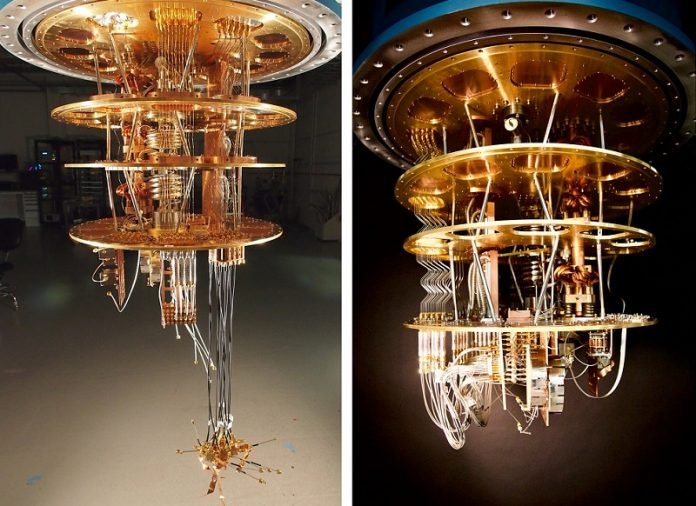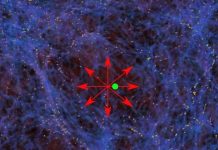
To understand quantum computing, we spoke to Erik Lucero, PhD, research scientist and site lead for Google Santa Barbara, the company’s Quantum AI campus.
Lucero ’05 began his studies at CU Denver, where he double majored in electrical engineering and physics.
Bits, Qubits, and Superposition
Before we move on to quantum computing, let’s demystify a few terms. Quantum simply means very small.
Quantum mechanics is humanity’s best theory explaining how nature behaves. Combine quantum with computers, and you have a computer that computes with quantum mechanics.
“We’re building a new type of computer,” Lucero explained.
“It’s important to understand what we have for computers today. We call those classical computers. A classical computer is like an abacus; its computation is governed by Boolean logic.”
The fundamental building blocks on a classical computer are called bits, which can be either 0 or 1. In quantum computing, the building blocks are called qubits (short for quantum bits). Qubits can exist on a spectrum.
“We describe this as a superposition—that is, the qubit can be both in zero and one at the same time. And with this richer set of computational space, a quantum computer replaces Boolean logic with laws of quantum mechanics.
In short, a quantum computer can explore a richer computational space than a classical computer. It’s not either, it’s both. How much is it in 0? How much is it in 1?” Lucero said.
What does it do?
The complex superposition of the qubits mimics how molecules behave in the real world. But what can quantum computers actually do?
“We believe quantum computers might be helpful for specialized applications that a quantum computer can do faster than a classical computer,” Lucero said. For example, quantum computing might be used to create more efficient batteries that don’t rely on rare-Earth metals.
Or it might positively affect how we feed the world. “One to two percent of all of humanity’s energy consumption goes into the production of fertilizer,” Lucero explained.
“With an error-corrected quantum computer, we believe we could model the chemical process nature uses to fixate nitrogen and turn it into fertilizer at much lower energy consumption.”
The super-fast quantum computer might also be used to invent and test new medical therapies. By modeling how the molecules would behave in a given scenario, scientists could save time and resources by avoiding making targeted medicines that won’t work.
“Those types of therapy are a big investment,” Lucero said. “If you could do the testing in simulation beforehand, you could make the drug discovery process cheaper.”
But first, Lucero and his team at Google need to improve their existing quantum computer, so it becomes an error-corrected quantum computer. In other words, it needs to correct any errors it makes as it goes through its calculations.
“We’ve published a roadmap,” Lucero said. “In the next 10 years, we believe we can build an error-corrected quantum computer.”
Right now, Google’s quantum computers are beginning to show how to correct errors (Nature, July 14, 2021).
And they have shown that for specific problems they can perform calculations on their quantum computer in hundreds of seconds that would take a supercomputer 10,000 years (Nature, October 23, 2019).
They are performing calculations at very fast speeds—exponentially faster than classical computers. Part of this is achieved through specialized refrigeration.
The quantum computers require cryostats (super refrigerators) to keep the superconducting qubits running smoothly. “Water freezes at 273 kelvin,” Lucero explained. “Our refrigerator gets down to 10 milli-kelvin—colder than intergalactic space.”
Photography captures technological progress
One of Lucero’s passions is photography, and he thinks it has similarities with quantum computing. In a recent episode of The Artian podcast, Lucero said both disciplines require “particular order and exquisite care.”
Lucero’s photographs have also served as a historical record of progress in the field of quantum computer processors.
“I have a cool lineage of all the processors I’ve worked on,” he said. “I share that with other folks on the team to encourage others to document in ways they can talk about their work by showing as well as explaining.”
His photographs help people see what quantum computers actually look like. “Images really bring things to life,” he said. For visual learners, this is quite helpful.
But Lucero has also gotten quite good at describing Google’s quantum processor. “It looks like a chandelier,” he said. “A big metal stage with a number of layers of beautiful wires.”
Beyond classical computations
Google’s goal is to build an error-corrected quantum computer. To accomplish this, Lucero and his team will rely on established science.
“We are standing on the shoulders of giants,” he said. He credits “Nobel prizes on top of Nobel prizes” for laying the groundwork for the Golden Era of quantum hardware.
He also credits CU Denver for part of his own success. “I want to highlight Martin Huber, a great advisor, mentor, and friend. Martin pulls off impressive research with undergraduates—world-class research that’s on par with any research university.” Lucero also credits Associate Professor Randy Tagg for his “great ability to teach intuition and get engineers excited about physics.”
Lucero, who is a first-generation college student, learned about the possibility of becoming a career researcher at CU Denver.
“I had no idea about graduate school as a trajectory,” he admitted. “The combination of opportunities I had at CU Denver, the talented professors that I had direct access to, the small class sizes, and amazing mentoring from Martin [Huber], allowed me to set graduate school as my goal.”
For the next decade, Lucero will have a new goal in addition to building an error-corrected quantum computer—to build his quantum computing team. “As a lead in this field, I’m thinking about the next wave of talent,” he said.
Written by Alicita Rodriguez.
Source: University of Colorado Denver.



